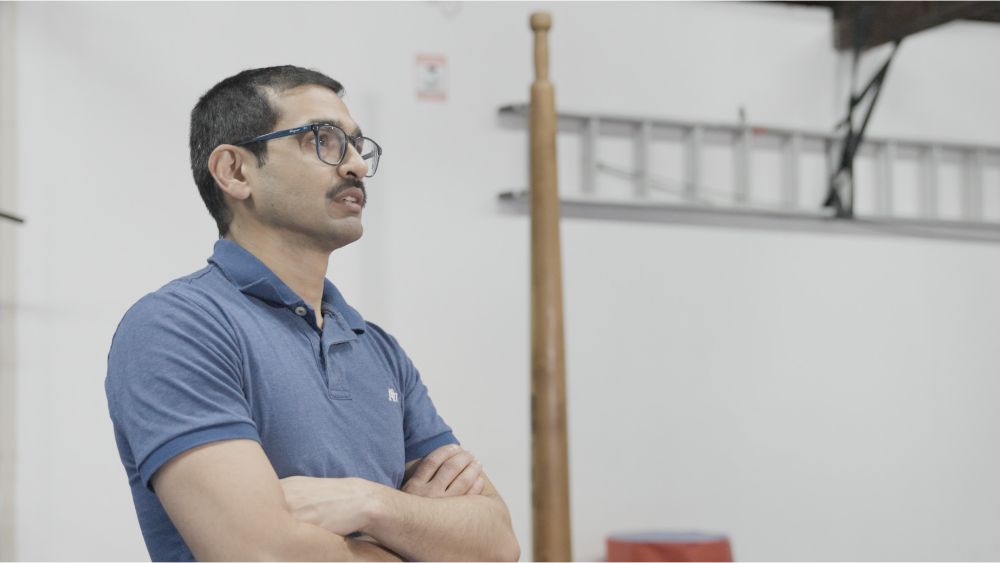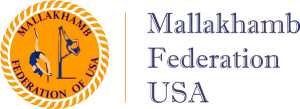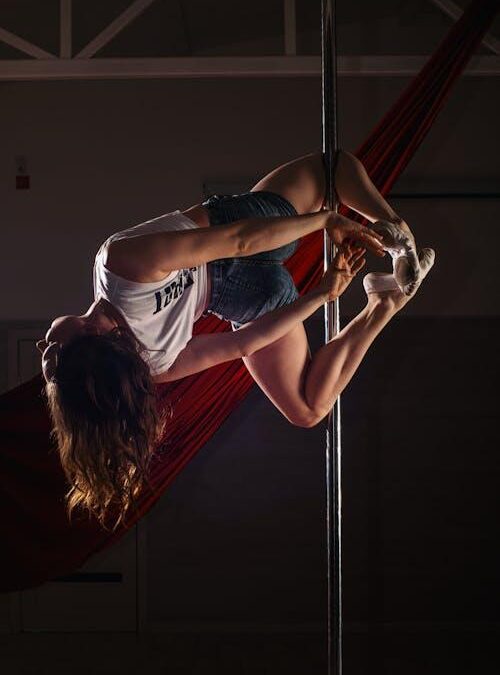Pole fitness has evolved into a comprehensive workout regimen that blends seamlessly with yoga. By incorporating yoga postures into pole exercises, practitioners can experience a harmonious blend of strength-building and mindfulness.
Pole fitness, at its core, involves dynamic movements centered around a vertical pole just like the traditional Indian Mallakhamb exercises. It involves a wide range of fitness techniques, including strength training, flexibility exercises, and cardiovascular conditioning. However, what sets this practice apart is its integration with yoga postures, which adds a new dimension to its benefits.
Yoga, renowned for its focus on breath control, meditation, and flexibility, complements pole fitness by infusing it with elements of balance. By incorporating yoga postures into pole exercises, individuals can enhance their physical endurance, mental focus, and overall well-being. This fusion allows practitioners to cultivate not only strength and flexibility but also inner peace and mindfulness.
Why are Pole Exercises with Yoga Getting Popular?
In recent years, there has been a noticeable surge in the popularity of combining pole exercises with yoga. As more people seek diverse and engaging ways to stay fit, they are turning to innovative fitness routines that offer a blend of physical challenge and mental relaxation.
One of the key factors driving this trend is the versatility of pole fitness and yoga. Unlike traditional gym workouts, which can feel monotonous and repetitive, pole exercises and yoga, or even Mallakhamb, offer a dynamic and engaging experience that appeals to individuals of all fitness levels. Whether you’re a seasoned athlete or a complete beginner, there is something uniquely captivating about the fusion of strength, grace, and mindfulness found in pole fitness and yoga.
Warm-Up and Cool-Down Routines
It’s crucial to prepare your body with a proper warm-up routine. Here are some effective warm-up exercises tailored specifically for pole fitness enthusiasts:
Joint Rotations
Start by gently rotating your wrists, elbows, shoulders, hips, knees, and ankles. This helps lubricate the joints and prepares them for movement.
Dynamic Stretches
Perform dynamic stretching exercises such as arm circles, leg swings, and torso twists. These movements help improve flexibility and range of motion while gradually increasing heart rate.
Cardiovascular Warm-Up
Incorporate light cardiovascular exercises like jogging in place, jumping jacks, or skipping rope for a few minutes. This helps raise your heart rate and boosts blood flow to your muscles.
Remember to listen to your body and avoid overexertion during warm-up. Aim to spend 5-10 minutes warming up before starting your pole fitness routine.
Relaxing with Yoga Postures after Intense Pole Exercises
After an intense pole fitness session, it’s essential to give your body the cooldown it deserves. Relaxing with yoga postures helps prevent muscle soreness and promote flexibility. Here are some yoga poses you can incorporate into your cooldown routine:
Child’s Pose (Balasana)
Sit back on your heels, stretch your arms forward, and lower your forehead to the mat. This gentle stretch releases tension in the back, shoulders, and hips.
Downward Facing Dog (Adho Mukha Svanasana)
From a plank position, lift your hips up and back, forming an inverted V shape with your body. This pose stretches the hamstrings, calves, and shoulders while calming the mind.
Seated Forward Fold (Paschimottanasana)
Sit on the floor with your legs extended in front of you, then fold forward from the hips, reaching for your feet or shins. This pose stretches the spine, hamstrings, and lower back.
Supine Spinal Twist
Lie on your back, bend your knees, and drop them to one side while twisting your torso in the opposite direction. This pose releases tension in the spine and promotes relaxation.
Take slow, deep breaths as you hold each pose for 1-2 minutes, allowing your body to unwind and release tension.
Cool down for at least 5-10 minutes to promote recovery and restore balance after your pole fitness workout.
Pole Grips and Techniques
Gripping the pole correctly is essential for executing pole fitness moves safely and effectively. Here are some essential pole grips and techniques you can master, along with yoga-inspired exercises to strengthen your grip:
Basic Grip
Wrap your hand around the pole with your thumb on top and fingers below, creating a secure grip. Practice holding onto the pole for increasing durations while maintaining proper alignment.
Tabletop Grip
Place your hand on top of the pole with your fingers spread wide and your palm facing down. Engage your core and lift your hips to create a tabletop position, strengthening your grip and upper body muscles.
Half Bracket Grip
Position your hand on the pole with your thumb pointing upward and your fingers wrapped around the pole. Bend your elbow and press your forearm against the pole, creating a half bracket shape. This grip strengthens your forearm muscles and improves stability.
How Yoga Postures Improve Grip Strength for Pole Fitness
Yoga postures not only promote flexibility and mindfulness but also contribute to building strength and stability, which are essential for mastering pole fitness. By integrating yoga poses into your pole fitness routine, you can improve your grip strength and overall stability.
Here’s how yoga postures can benefit your pole fitness practice:
Forearm Plank
Start in a plank position with your forearms on the ground, elbows directly below your shoulders. Engage your core and hold the pose for 30-60 seconds, focusing on maintaining a strong and stable alignment.
This pose strengthens the muscles in your forearms, wrists, and core, improving your ability to maintain grip strength during pole exercises.
Eagle Pose (Garudasana)
Stand tall and cross your right thigh over your left thigh, then hook your right foot behind your left calf. Extend your arms forward and cross your right arm under your left, bringing your palms together.
Hold the pose for 30 seconds to 1 minute, then switch sides. Eagle pose improves balance, stability, and concentration, which are essential for mastering intricate pole fitness moves.
Handstand Prep
Start in a downward-facing dog pose, then walk your feet closer to your hands until your hips are stacked over your shoulders. Engage your core and lift one leg up towards the ceiling, finding balance on your hands.
Hold for a few breaths, then switch legs. This pose builds upper body strength, shoulder stability, and confidence, helping you perform advanced pole fitness maneuvers with ease.
Conclusion
The fusion of pole fitness and aerial yoga, enriched with yoga postures, offers a holistic approach to physical well-being and mindfulness. Adding Mallakhamb techniques to your routine adds to the overall holistic strengthening.
By integrating yoga-inspired exercises into pole fitness routines, practitioners can experience a harmonious blend of strength, flexibility, and inner peace.
From effective warm-up routines for pole fitness enthusiasts to relaxing techniques infused with yoga postures, every aspect of the pole fitness is designed to nurture the body and mind. From pole grips to yoga techniques, yoga postures unlock new heights of physical potential.
As this trend continues to gain momentum and more individuals embrace pole fitness and yoga, we are reminded that true wellness encompasses strength, flexibility, and inner harmony.
So, let’s continue to soar to new heights, both on the pole and within ourselves, embracing the journey with grace, strength, and unwavering determination.
FAQs
1. How do you train for pole fitness?
Training for pole fitness involves a combination of strength, flexibility, and technique. Regular practice, attending classes, and following structured workout routines can help improve your skills and progress in pole fitness.
2. What are pole exercises?
Pole exercises consist of a variety of movements and techniques performed on a vertical pole. These exercises focus on building strength, improving flexibility, and enhancing overall fitness while incorporating elements of dance and acrobatics.
3. Is pole good for fitness?
Yes, pole fitness is an excellent workout for improving strength, flexibility, and cardiovascular health. It engages multiple muscle groups, enhances core stability, and promotes overall body coordination, making it a comprehensive fitness regimen.
4. How can I practice pole fitness at home?
You can practice pole fitness at home by investing in a sturdy pole for your space and following online tutorials or instructional videos. Start with beginner-friendly exercises and gradually progress as you build strength and confidence.
5. How can I improve my strength for pole exercises?
To improve strength for pole exercises, incorporate strength training exercises such as push-ups, pull-ups, and core exercises into your workout routine. Additionally, practicing pole-specific moves and grips regularly will help build functional strength for pole fitness.
6. How can I improve my pole flexibility?
Improving pole flexibility requires consistent stretching and mobility exercises. Incorporate dynamic stretches, static stretches, and yoga poses targeting areas such as hamstrings, hips, and shoulders to enhance overall flexibility for pole fitness.
7. How do I improve my pole grip?
Improving pole grip involves practicing different pole grips and techniques regularly. Strengthen your grip by incorporating grip-specific exercises such as towel hangs, forearm squeezes, and finger strength exercises into your training routine. Additionally, using grip aids such as grip powders or gloves can help enhance your grip on the pole.


